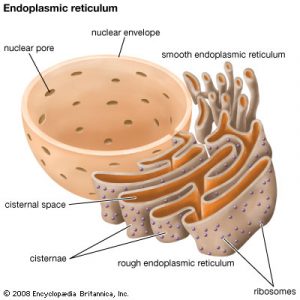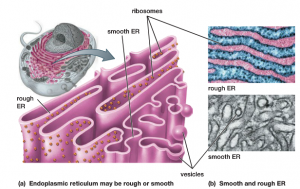Endoplasmic Reticulum
Endoplasmic Reticulum
The endoplasmic reticulum (ER) is an extensive and complex network of interconnected tubes and flattened sacs making up over 50% of the total amount of membrane found in the cell. The ER is surrounded by a single membrane that is connected to the outer membrane of the nuclear envelope. The ER plays a major role in producing all of the phospholipids used for membrane construction in the cell as well as protein production; proteins destined for other cellular compartments, for the plasma membrane, or for export from the cell are produced in the ER.

Endoplasmic Reticulum
In the manufacturing plant example where the nucleus functions as the administrative offices of the cell, the endoplasmic reticulum can be viewed as the factory floor where the cell’s chemical building blocks are assembled.

Inside the cell, there are two types of ER which differ in appearance and function:
- Rough Endoplasmic Reticulum (Rough ER)
- Smooth Endoplasmic Reticulum (Smooth ER)

Rough ER
- Portions of the ER membranes have small rounded particles associated with them that are exposed to the cytosol. Such ER is referred to as rough ER, and the particles are ribosomes.
- Ribosomes manufacture proteins using amino acid building blocks by following instructions provided by DNA in the nucleus.
- Ribosomes attached to the rough ER manufacture proteins that are destined for the ER interior, for insertion into a membrane (including the plasma membrane), or for export from the cell.
Smooth ER
- In some cells, a percentage of the ER membrane lacks ribosomes and is therefore called smooth ER. The smooth ER provides sites where portions of the ER membrane actively bud off to produce vesicles, small containers which contain a small portion of the ER interior. These vesicles are then transported to other regions of the cell.
- In some cells, smooth ER is used to produce large quantities of lipids such as steroid hormones. Smooth ER is also abundant in liver cells, where it contains enzymes that detoxify harmful drugs such as alcohol and metabolic wastes such as ammonia.
- In the manufacturing plant example, vesicles are like carts used to transport goods between different departments.
Endoplasmic Reticulum
In the video below, features of the Endoplasmic Reticulum and a comparison between Rough and Smooth ER is discussed.
Summary
The endomembrane system within eukaryotic cells includes the nuclear envelope, endoplasmic reticulum (ER), Golgi apparatus, lysosomes and other vesicles. The ER forms a series of interconnected membrane-enclosed tubes and compartments where the majority of the cell’s membranes are produced. There are two types of ER, Smooth and Rough, distinguished by the presence of protein-producing ribosomes.
The endoplasmic reticulum serves as the assembly line of the cell.